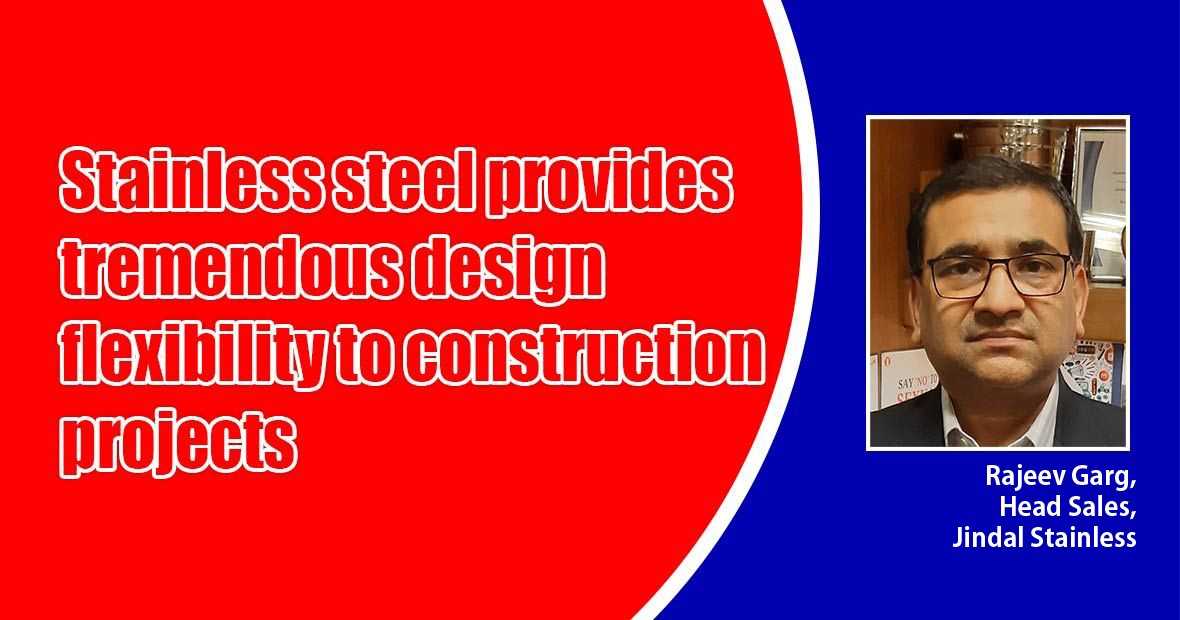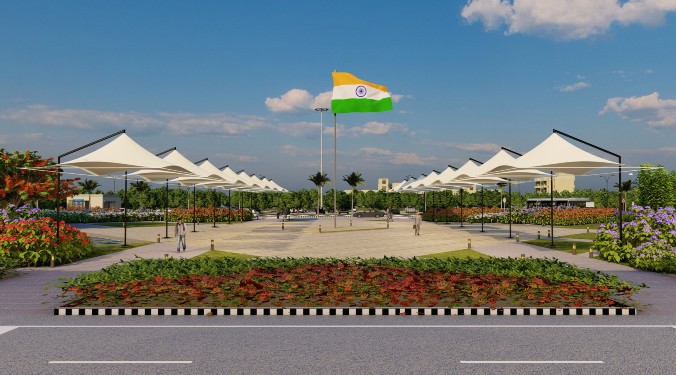Stainless steel provides tremendous design flexibility to construction projects

Besides that stainless steel is an aesthetic metal and also imparts a much needed visual appeal says Rajeev Garg, Head, Sales, Jindal Stainless
How did stainless steel replace the existing ways and methods of constructing buildings and become a preferred building material in many projects?
Stainless steel is a modern day metal. It is corrosion-resistant, durable, and environment friendly; making it the fastest growing metal in the world with a CAGR of more than 5%. As per NACE International’s IMPACT study, it was estimated that the global cost of corrosion was around 3-4% of the global GDP. Consequently, stainless steel has amassed popularity for a wide variety of applications owing to its sustainable nature, when compared to its competitors.
New-age infrastructural planning lays emphasis on the Life Cycle Cost (LCC) factor. It takes into account the initial installation cost, low-maintenance cost, high end-of-life value, and long service life of the metal. With an LCC ~75% lower in comparison to galvanized steel, depending upon the environment & the pollution levels, stainless steel has proven to be more cost-effective.
Moreover, stainless steel is virtually maintenance-free. Appropriate stainless steel grade selection and minimal maintenance can make stainless steel last as long as the project’s life.
What role does it play in the contemporary construction sector?
Apart from being corrosion-resistant, stainless steel has an improved strength-to-weight ratio, high tolerance to extreme temperatures, longer life, and minimal maintenance requirement. For these reasons, stainless steel is making inroads among infrastructural projects in the most severe environments. These include projects like highway bridge decks, overpasses, tunnels, marine structures, and restoration work where corrosive conditions can cause premature structure failures. The ~7500km Indian coastline is a major economic and complex challenge for civil engineers due to the untimely damage to infrastructure due to corrosion. Stainless steel has been proven to be the best solution under such extreme environments. It provides improved structural strength and defies corrosion, thus offering long-lasting solutions for the construction segment.
Apart from this, stainless steel is an aesthetic metal and imparts visual appeal to the structure. It is mainly used in pipe and tube forms. The potential of the segment can be estimated from the current market size of the Indian decorative stainless steel pipe & tube market which is nearly Rs 7,000 crore, and it is growing at 10-12%. In a growing and rapidly urbanizing country, stainless steel proves to be the most sustainable and optimum choice. Stainless steel decorative pipes and tubes are deployed for a variety of applications like coastal infrastructure, ornamental and structural applications, heat exchangers, hollow sections, exhausts, water pipeline, food & beverage, sugar industry etc. The current pandemic has also revealed new and rising applications of stainless steel pipes and tubes in sanitizer dispensing machines, hand washing stands, and hospital beds, among others.
Owing to its structural strength, stainless steel rebars and plates are key components of present-day civil infrastructure, like foot-over-bridges (FOBs) and road-over-bridges (ROBs). Jindal Stainless has been supplying stainless steel structural steel for railway infrastructure. The Company had recently signed an MoU with Braithwaite & Co. Limited, a Government of India undertaking under the Ministry of Railways, which undertakes structural work for the Indian Railways. Stainless steel is a contemporary solution for modern infrastructure projects like redevelopment of railway stations, new highways, and upcoming metro projects. The first such stainless steel foot-over-bridge is coming at Bhayandar station in Mumbai this year. Moreover, transit building projects such as airport and metro transport systems use stainless steel for applications like bollards, column cladding, ticketing counters, escalators, elevators, handrails, station canopies, etc.
What are the advantages and limitations of using stainless steel?
Stainless steel provides tremendous design flexibility to construction projects- ranging from cutting edge architectural designs to setting up a robust public infrastructure. It also ensures impeccable strength, resistance to corrosion and fire, and a longer life cycle. Moreover, the metal comes with an intrinsic aesthetic appeal. It needs no, in some cases minimal as per applications, external paint or coating. This makes stainless steel a practical choice for public and industrial projects. Although initial installation costs of stainless steel are comparatively high, the metal proves to be economical given its long service life when compared to other materials that require constant maintenance.
Stainless steel is essentially a green metal. As mentioned before, it is nearly 100% recyclable as it uses its own scrap as a key raw material. Moreover, stainless steel is inert in nature and perfectly complements environmental variations. Choosing the right grade of stainless steel for specific applications can even lead to the stainless steel structure to last as long as the life of the project. The metal has empowered discussion on the need for a modern-day, ecological infrastructure among the architect and engineer fraternities.
Cookie Consent
We use cookies to personalize your experience. By continuing to visit this website you agree to our Terms & Conditions, Privacy Policy and Cookie Policy.









